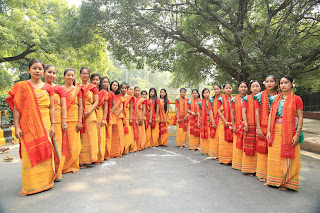Garment or Fabric of Assam
Assam is known for its weaves but
also for its silk. Silk is the "queen of fabrics". Its strength, lustre,
softness and graceful fall make it the most attractive of all textiles. No
other natural fibrecan rival its versatility.
Muga
 |
| Muga Silk (Pic. Source Google) |
This golden yellow silk is unique
to India.Muga is spun by the worm Antheraeaassama which feeds on som and arjun
tree leaves. It is known for its natural shimmering golden color and its
sumptous, sensual look. The most expensive silk,muga is woven into the cultural
traditions of the Assamese people.Muga has the ability to absorb moisture
better than any others it’s very durable due to highest tensile strength. Muga
is available in shades of natural gold.The golden colour and shine increase
with every hand wash.Muga silk is commercially available only from India. While
it has a naturally golden lustre and does not need dyeing, it is compatible
with most dyes.
Mulberry
 |
| Mulberry silk ( Pic. Source Google) |
Mulberry silk is exclusively obtained
from the silkworm of Bombyxmori moth. The worm feeds only on the leaves of the mulberry
plant. Mulberry silk is also known as pure silk.The Indian mulberry is
comparatively softer in texture, very smooth, strong with a shimmering lustre.Mulberry
silk can be fabricated into the most versatile designs and is available in a
wide range of rich shades. It is lightweight and drapes well.
Eri
 |
| Eri Silk |
Eri is derived from the Assamese
word 'era', for castor as the silkworm feeds on Castor plants. Eri is a
multivoltine silk spun from open-ended cocoons.The fabric’s texture is coarse,
fine and dense with a matte finish and intrinsic sheen.It is strong, durable
and elastic. Eri is wooly white colored or reddish, non-mulberry silk fabric,
which is known as Ahima silk or the fabric of peace; also known for its warmth.
Tasar
 |
| Tasar Silk |
Tussar or Tasar Silk is one of
the commercial silk in India. Available naturally in shades of muted gold and
mild beige, it is a fine, durable fabric. Also known as kosa silk, it is highly
valued for its purity and linear weaving texture. Antheraeamylitta and
Antheraeaproylei are the two main tussar silkworms that feedon the leaves of
arjun and salto produce the Tussar silk.Tussar silk is used for
furnishing,dress materials, sarees and other garments. It is also blended with
other kinds of silk, wool, cotton etc to manufacture different fabrics. Tussar
is considered ideal as well as auspicious for marriages, religious ceremonies
and other functions.











